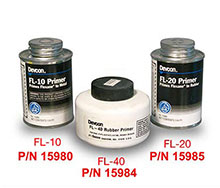RUBBER ROLL REPAIR/RUBBER LININGS
RUBBER ROLL REPAIR/RUBBER LININGS
Flexane’s ability to “adjust” its durometer has always been an excellent feature in helping to repair rubber rolls in the paper industry. The rubber-lined condenser water boxes also provide an excellent application for our Flexane products. These two applications are done in the field today. Roll repairs require a careful surface preparation and application savy to ensure the Urethane material adheres to both the metal shaft and rubber coating. Here is a typical application for a rubber roll:
- Surface Preparation: Clean the surface of the rubber roll to get all oils and greases out of the surface. Follow the Degreasing Section of this manual. Then while the roll is on the lathe, machine the worn rubber completely off the roll. You may take the rubber down to the metal “core” shaft or just “undercut” the rubber at least a 1/8”. Be sure to leave a “distinct” edge on both sides of the worn area. Figure 1
- After the roll has been completely cleaned, apply FL-10 Metal Primer to the metal “core” of the roll and than apply FL-20 Rubber Primer to the “edges” of the rubber and over to the FL-10.
Note: If you are only going to machine a small portion of the rubber off this roll to rebuild the roll back to its original shape, make sure the “edges” of the roll are coated with FL-20 Primer. This is essential for good adhesion. Figure 2
- After all the priming has been completed, you are ready to apply the Flexane material. Have the lathe move slowly in a clockwise direction. As the roll is “turning”, start to apply the Flexane material. Be sure to compress the urethane onto the metal shaft and into the “edges” of the existing rubber. Try to make the finish of the repair as smooth as possible. Let the lathe spin for a few hours, allowing the Flexane material to “set-up” and cure.
Note: Sometimes a “thick” build up of urethane material, if not continuously kept in motion,will tend to “drop off” or “seg”. Figure 3
Now you are ready to machine the rubber repair. Machining the repair can be difficult. Remember the frictional heat that builds up when machining will cause the Flexane to “rip and tear” leaving a rough surface.
Machining instructions: For grinding, use a No. 60 diamond wheel. For machining, use a carbide bit, taking a “smell pass” without generating a great amount of frictional heat. Figure 4






